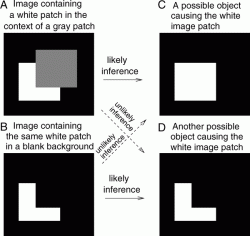|
From rxpgnews.com Cognitive Science Scientists at UCL (University College London) have found the link between what we expect to see, and what our brain tells us we actually saw. The study reveals that the context surrounding what we see is all important – sometimes overriding the evidence gathered by our eyes and even causing us to imagine things which aren’t really there. The paper reveals that a vague background context is more influential and helps us to fill in more blanks than a bright, well-defined context. This may explain why we are prone to ‘see’ imaginary shapes in the shadows when the light is poor. Eighteen observers were asked to concentrate on the centre of a black computer screen. Every time a buzzer sounded they pressed one of two buttons to record whether or not they had just seen a small, dim, grey ‘target’ rectangle in the middle of the screen. It did not appear every time, but when it did appear it was displayed for just 80 milliseconds (80 one thousandths of a second). “People saw the target much more often if it appeared in the middle of a vertical line of similar looking, grey rectangles, compared to when it appeared in the middle of a pattern of bright, white rectangles. They even registered ‘seeing’ the target when it wasn’t actually there,” said Professor Zhaoping, lead author of the paper. “This is because people are mentally better prepared to see something vague when the surrounding context is also vague. It made sense for them to see it – so that’s what happened. When the target didn’t match the expectations set by the surrounding context, they saw it much less often.
“Illusionists have been alive to this phenomenon for years,” continued Professor Zhaoping. “When you see them throw a ball into the air, followed by a second ball, and then a third ball which ‘magically’ disappears, you wonder how they did it. In truth, there’s often no third ball - it’s just our brain being deceived by the context, telling us that we really did see three balls launched into the air, one after the other. “Contrary to what one might expect, it is a vague rather than a bright and clearly visible context that most strongly permits our beliefs to override the evidence and fill in the blanks. In fact, a bright and clearly visible context actually overrides the evidence in the opposite direction - suppressing our ‘seeing’ of the vague target even when it is present. “Mathematical modelling suggests that visual inference through context is processed in the brain beyond the primary visual cortex. By starting with a relatively simple experiment such as this, where visual input can be more easily and systematically manipulated, we are gaining a better understanding of how context influences what we see. Further studies along these lines can hopefully enable us to dissect the workings behind more complex and wondrous illusions.” All rights reserved by RxPG Medical Solutions Private Limited ( www.rxpgnews.com ) |
